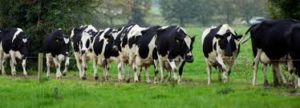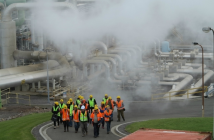The injury-prone dairy farming industry was the ideal sector in which to test the learning from incidents process, as Massey University researchers Justine Croft & Dr Kirsten Bendix Olsen explain
The dairy sector has one of the highest injuries rates of any New Zealand industry – 2.5 times higher per 1000 full-time equivalents than the average of all industries combined.
The latest Accident Compensation Corporation statistics show there were 334 years lost time due to injury each year between 2008 and 2013 – yet there is a paucity of research into the ‘learning from incidents’ process within this industry.
The aims of the study were threefold:
- identify the ‘learning from incident’ process in a dairy farming organisation and compare this process with the theoretical step-wise learning from incidents model developed from the chemical and manufacturing industry by researcher Dr Linda Drupsteen’s research team in the Netherlands
- test Drupsteen and Hasle’s method for identifying barriers to learning from incidents in a dairy farming organisation
- identify the barriers in this dairy farming group and what could be changed to improve learning from incidents.
The study was based on the eight steps for successful change management outlined by leading change specialist J.P. Kotter in the Harvard Business Review in 2007:
- establish a sense of urgency
- form a power-guiding coalition
- create a vision
- communication – “walk the talk”
- empower others and remove barriers
- short-term wins
- consolidate the improvements by constant reassessment
- institutionalise the new approach.
The case study involved a company that owned and operated nine dairy farms and employed 65 people, including three operational managers each supervising 3-4 farms, and supporting farm managers.
It began with an interview with the firm’s H&S manager to identify:
- the learning from incident process
- participants for focus group interviews
- two incidents – one with successful learning and one without.
Deep discussions
Two separate focus group interview were then conducted with health and safety representatives and farm managers, including supervising managers, to identify general learning and learning related to the two incidents.
These were followed by thematic analysis of interviews to identify:
- the learning process (and different understandings of it)
- the barriers to learning
- how the learning process could be improve
The focus groups first identified:
- the ‘learning from incident’ process as they understood it
- what in the ‘learning from incident process’ worked well and what didn’t
- why steps in the learning process didn’t work well (e. barriers)
- improvements which could reduce these barrier
The results were interesting as no one individual or group fully identified the process for learning from incidents within this company, and each group showed little awareness of the process outside of their own involvement.
Barriers identified included a reluctance to report incidents, which were seen as a low priority in terms of the daily workload – although the largest farm said it was “too busy not to”.
Other problems included a fear of blame, or perception of stupidity, embarrassment; the incident not being perceived as serious enough to report; and a ‘kiwi bloke’ attitude; as well as a reluctance to have to retrain.
Additional hindrances included:
- a lack of investigative skills
- cancellation or postponement of weekly team meetings
- issues not shared amongst staff from other farms within the group
- the summary of incidents was too brief, lacking in detail and “disinfected” by the categorisation process
- a poor follow-up process to ensure recommended actions were implemented
- and a policy manual too large to be effectively read and understood.
Subsequent focus groups discussed the two specific incidents selected by the H&S manager and whether the participants believed there had been a successful learning outcome, why they thought it had been successful or not, what had changed and why had it changed or not.
Differing views
The H&S manager thought the first incident resulting in leptospirosis had a “successful learning outcome”, writing a new policy and delivering PPE and the policy document to every cowshed.
However, the focus groups saw it as an “unsuccessful learning outcome”, recognizing that staff and managers had ignored both the PPE and the policy and no practice had changed as a result.
Interestingly, the second incident involving detritus in the paddock was viewed by the H&S manager as having an unsuccessful learning outcome because the problem continued to occur.
Conversely, the focus groups saw it as having a successful learning outcome, a Paddock Warrant of Fitness (WoF) having been reinforced on all but one farm that was seen as an “outlier” that needed to be brought into line.
Tellingly, all supervisors and managers placed a strong emphasis on the WoF, which is now seen as part of the DNA of the company and part of the daily work routine.
The difference was simply managers ‘walking the talk’ and enforcing the desired routine behaviour by establishing and encouraging a “powerful guiding coalition” to champion the change.
The process also illustrated a lack of understanding of both ‘organisational learning’ and ‘change management’ processes, and the necessity to follow up to ensure efficient implementation of actions and long-term learning.
Clearly the methodology for learning from incidents transposed well to the dairy industry from the chemical and manufacturing industries in the Netherlands, and worked well in identifying both the process and barriers to learning from incidents.
These barriers were particularly related to lack of commitment by the managers, especially relative to their commitment to the rest of the business such as milk
production, and related well to John Kotter’s organisational learning barriers.
This, admittedly, was a small piece of research involving a small case study, but it’s clear that it’s important to have an outside person managing the research process, which should be repeated to see if it replicates before developing the methodology on other farms and other industries.




